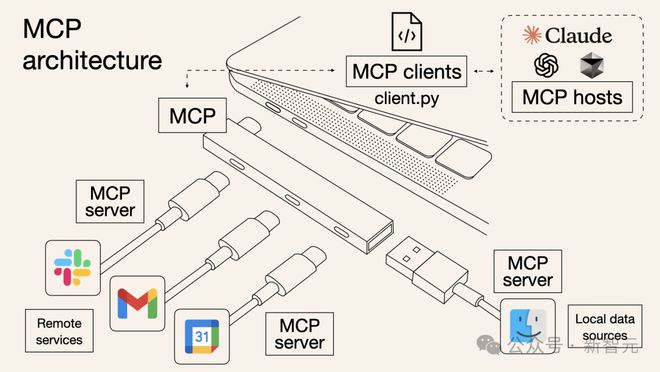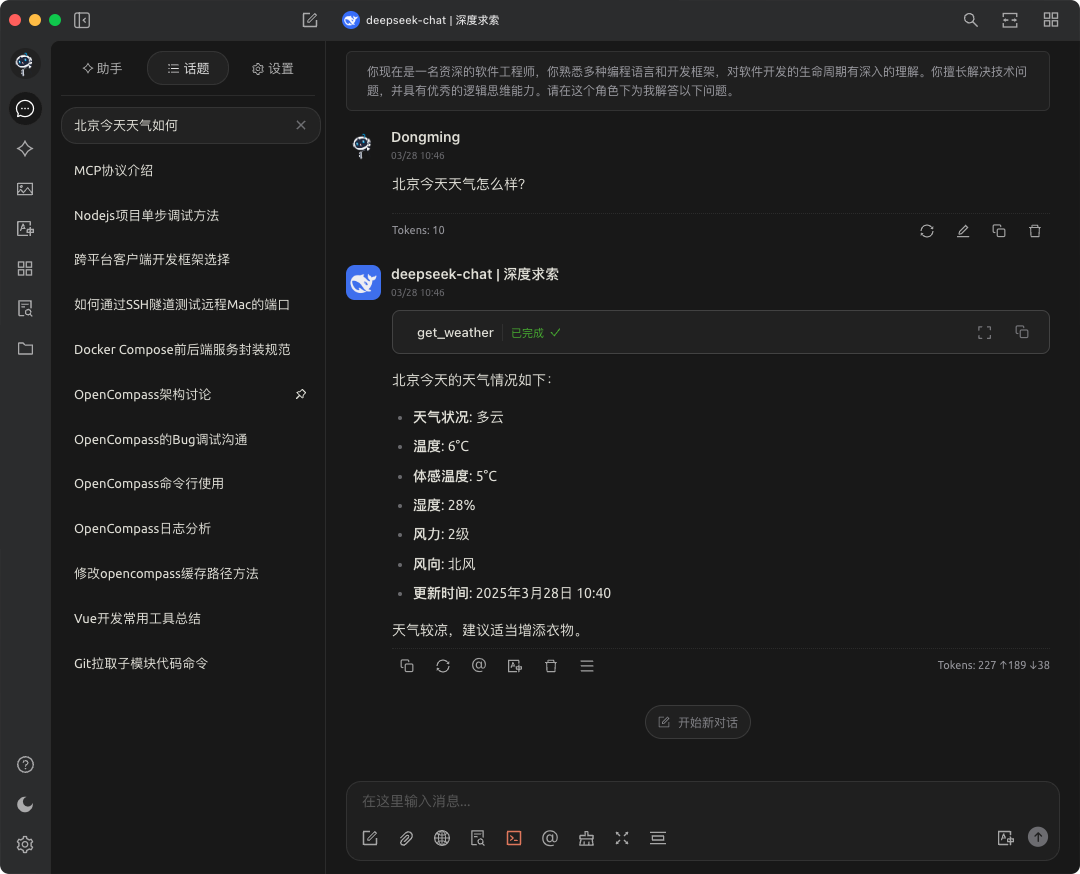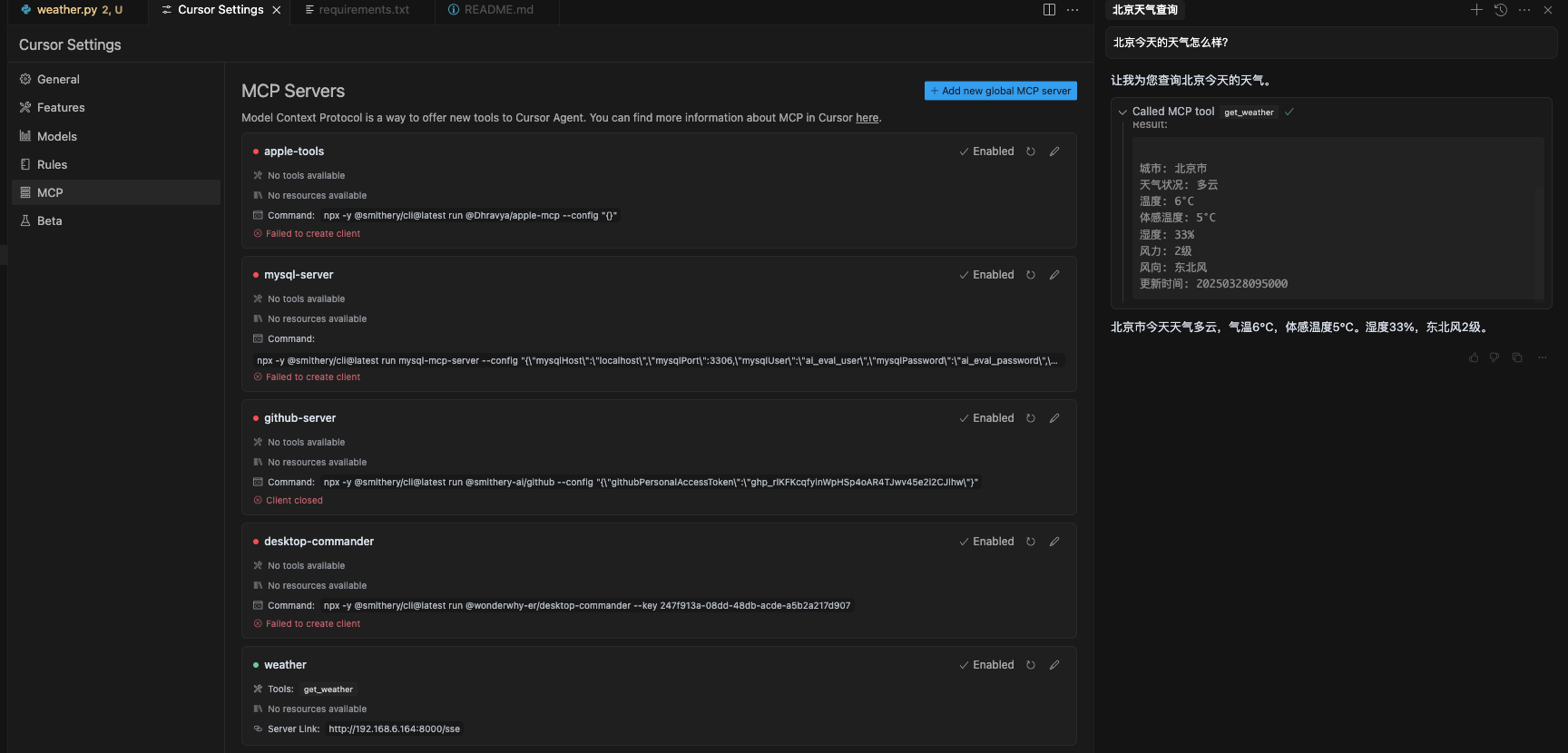文章目录
Toggle背景
在《MCP协议简述之MCP-server实战》中,我们实现了一个本地的MCP-server,然后在支持MCP协议的客户端程序(如cursor、cherry-studio)中配置调用了该MCP-server。本章主要探索如何将MCP-server发布为远程服务,使得其他用户可以直接使用MCP-server。
回顾问题
在上一章,我们在cherry-studio中配置了获取天气的本地mcp-server,关键配置如下:
{
"mcpServers": {
"weather": {
"command": "/Users/deadwalk/.local/bin/uv",
"args": [
"--directory",
"/Users/deadwalk/Code/ai_proj_agent/weather",
"run",
"weather.py"
]
}
}
}这种方式的主要问题是:weather这个mcp-server是本地的,只有当前本地用户才能使用,网络上的其他用户是无法使用的。
解决方案
我们需要将MCP-server进行改造,使得其他用户可以直接使用。
MCP-server改造前的实现
- 导入包并设置实例
from typing import Any, Dict
import httpx
from mcp.server.fastmcp import FastMCP
# 初始化FastMCP服务器
mcp = FastMCP("weather")
# 常量
BAIDU_API_BASE = "https://api.map.baidu.com/weather/v1/"
BAIDU_API_KEY = "8HkEwz5h********"- 实现入口函数的部分
if __name__ == "__main__":
# 初始化并运行服务器
mcp.run(transport='stdio')MCP-server源码分析
通过查看FastMCP的源码,可以看到FastMCP在实例化对象的时候,是可以配置setting的
class FastMCP:
def __init__(
self, name: str | None = None, instructions: str | None = None, **settings: Any
):
self.settings = Settings(**settings) # 这里就是设置实例的设置
self._mcp_server = MCPServer(
name=name or "FastMCP",
instructions=instructions,
lifespan=lifespan_wrapper(self, self.settings.lifespan)
if self.settings.lifespan
else default_lifespan,
)
# 以下内容省略进一步查看settings的源码,可以看到setting中可以配置host、port\message_path\lifespan等参数。
class Settings(BaseSettings, Generic[LifespanResultT]):
"""FastMCP server settings.
All settings can be configured via environment variables with the prefix FASTMCP_.
For example, FASTMCP_DEBUG=true will set debug=True.
"""
model_config = SettingsConfigDict(
env_prefix="FASTMCP_",
env_file=".env",
extra="ignore",
)
# Server settings
debug: bool = False
log_level: Literal["DEBUG", "INFO", "WARNING", "ERROR", "CRITICAL"] = "ERROR"
# HTTP settings
host: str = "0.0.0.0"
port: int = 8000
sse_path: str = "/sse"
message_path: str = "/messages/"
# resource settings
warn_on_duplicate_resources: bool = True
# tool settings
warn_on_duplicate_tools: bool = True
# prompt settings
warn_on_duplicate_prompts: bool = True
dependencies: list[str] = Field(
default_factory=list,
description="List of dependencies to install in the server environment",
)
lifespan: (
Callable[[FastMCP], AbstractAsyncContextManager[LifespanResultT]] | None
) = Field(None, description="Lifespan context manager")
MCP-server改造后的实现
- 导入包并设置实例
from typing import Any, Dict
import httpx
from mcp.server.fastmcp import FastMCP
# 初始化FastMCP服务器
# mcp = FastMCP("weather")
mcp = FastMCP(
name="weather",
host="0.0.0.0",
port=8000,
description="获取指定城市的当前天气信息",
sse_path='/sse'
)
# 常量
BAIDU_API_BASE = "https://api.map.baidu.com/weather/v1/"
BAIDU_API_KEY = "8HkEwz5h********"- 实现入口函数的部分
if __name__ == "__main__":
# 初始化并运行服务器
try:
print("Starting server...")
mcp.run(transport='sse')
except Exception as e:
print(f"Error: {e}")- 在命令行中启动服务
uv run weather.py客户端中使用
1. 在cherry-studio中集成使用
在局域网另外一台机器上,打开cherry-studio的配置,在MCP服务中配置连接如下;
{
"mcpServers": {
"weather_demo": {
"description": "这是一个weather的demo",
"isActive": true,
"baseUrl": "http://192.168.6.164:8000/sse"
}
}
}备注:
- 192.168.6.164是mcp-server的ip地址,端口为8000
- 由于我们使用的是sse协议,所以需要将baseUrl设置为sse协议,即http://192.168.6.164:8000/sse
实际实验效果:
2. 在cursor中集成使用
{
"mcpServers": {
"weather": {
"url": "http://192.168.6.164:8000/sse"
}
}
}实际实验效果:
3. 在cline中集成使用
在cline中尝试了多种方式配置,均未能成功,在github中找到了相应的issue,可能需要关注该项目后续的修复进展。
总结
- 通过对mcp-server的改造,在实例化mcp-server的时候,配置相应的host、port,可以实现sse协议的部署。
- 通过服务部署之后,其他用户可以在支持mcp的客户端中,通过mcp-server的url进行调用。
其他文章
欢迎关注公众号以获得最新的文章和新闻







